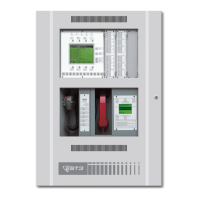Power-up and testing
EST3 Installation and Service Manual 6.7
Control and emergency communications equipment testing
The procedures listed in the following sections should be
performed on the equipment installed in each cabinet connected
to the system. These procedures are designed to test the
hardware and its installation. The applications programming will
be tested later.
Note: The network configuration information must be
downloaded into the network and Audio Source Unit, using the
System Definition Utility (SDU) program, before starting testing.
Primary power supplies
1. Verify that all components are installed using accepted
workmanship standards.
2. Verify adequate separation between power-limited and
nonpower-limited wiring. Refer to NFPA 70, article 760, of
the National Electrical Code.
3. Verify that the installed batteries are the proper capacity for
the application.
4. With the batteries disconnected, verify that the supply’s full
alarm load can be sustained by the power supply without the
batteries connected.
5. With the batteries connected, disconnect the AC source and
verify that a power supply trouble is annunciated, and that
the supply’s full alarm load can be sustained by the batteries.
6. Verify that the battery charger properly charges the batteries
connected to both the primary and booster power supplies to
80% capacity within 24 hours.
Booster power supplies
1. Verify that all components are installed using accepted
workmanship standards.
2. Verify adequate separation between power-limited and
nonpower-limited wiring.
3. Verify that the installed batteries are the proper capacity for
the application.
4. With the batteries disconnected, verify that the supply’s full
alarm load can be sustained by the power supply without the
batteries connected.
5. With the batteries connected, disconnect the AC source and
verify that a power supply trouble is annunciated, and that
the supply’s full alarm load can be sustained by the batteries.

